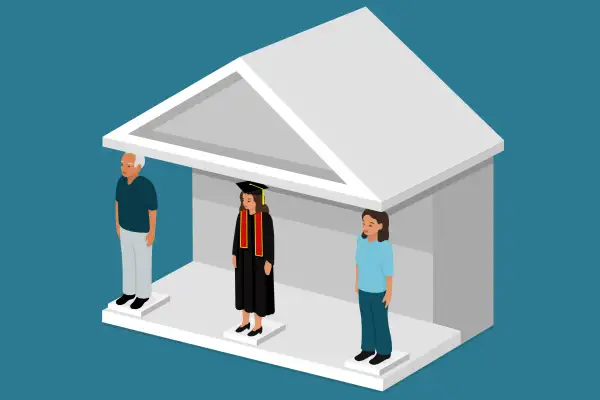Parent PLUS Loans: A Guide to Helping Your Student Pay for College

A large portion of college students take out their own loans, turning to federal student loans and private loans, personal loans or even using credit cards to help pay for college. However, there are also many parents who want to pitch in – either to help their kids cover high educational expenses or because those young adults are unable to qualify for enough funding on their own.
Roughly one in five parents borrow money on their children’s behalf to help pay for college, according to a recent survey by Sallie Mae. These borrowed funds came from a variety of sources, including private student loans, home equity loans or lines of credit (HELOCs), or even borrowing from a retirement account. The most popular source, though, was a federal Parent PLUS loan.
Parent PLUS loans are federal student loans offered by the U.S. Department of Education to the parents of eligible undergraduate students, including stepparents and adoptive parents. They can be used to pay for tuition and other qualifying educational expenses, including room and board, books, supplies and fees.
Here’s a look at how much Parent PLUS loans cost and how parents can use them to help pay for their kids' undergraduate studies.
Table of contents:
- How do Parent PLUS loans work?
- Alternatives to Parent PLUS loans
- How to apply for a parent loan
- Forgiveness and repayment options for Parent PLUS loans
How do Parent PLUS loans work?
With a Parent PLUS loan, the parent is the borrower, rather than the student. This means that the parent is responsible for qualifying for the loan and repaying the loan once any deferment period ends.
The maximum borrowing limit on a Parent PLUS loan is the actual cost of attendance (including tuition, room and board, fees, books and miscellaneous costs) as determined by the school, minus any other financial aid sources offered to the student (such as scholarships or grants). This means that you can borrow as much as you need to pay for college and all related educational expenses, as long as the parent borrower qualifies and doesn’t have an adverse credit history. (More on that below)
As with other federal student loans, Parent PLUS loans are disbursed directly to the school. If any funds remain after applicable tuition and educational expenses are paid, they will be issued back to the parent or, in select cases, to the student.
These loans are issued with a fixed interest rate that remains the same for the duration of the loan repayment period. For the 2024-2025 academic year, the Parent PLUS interest rate is 9.08%. There is also an origination fee, which impacts the overall cost of the loan. This fixed, one-time fee is deducted from the initial disbursement of the funds; as of this writing, the fee on a Parent PLUS loan is 4.228%.
With a Parent PLUS loan, loan repayment begins after funds are disbursed, unless the borrower requests to defer repayment until the student has graduated or withdrawn from school. In the case of a deferment, parent borrowers will have a six month grace period after the student graduates (or otherwise drops below half-time enrollment) before payments are due.
Note that Parent PLUS loans are unsubsidized loans. This means that even with an approved loan deferment, interest will begin to accrue on the balance right away, regardless of the repayment term or deferment plan chosen.
Parent PLUS loans can still qualify for federal loan forgiveness programs, such as Public Service Loan Forgiveness (PSLF), if certain requirements are met after the student graduates. Parent borrowers would have to consolidate their student debt with a Direct Consolidation Loan and then enroll in a specific repayment plan — called Income-Contingent Repayment — that sets their monthly bill based on how much they earn. The consolidation process combines all of your loan balances into one account with one interest rate (based on the average of each loan’s rate), so it is different than refinancing.
- Available for the full cost of attendance
- Utilize the parent's credit history and may be easier to qualify for
- Still eligible for some student loan forgiveness options and an income-driven repayment (IDR) plan
- Can be used for tuition, fees, room, board (or meal plans), books and more
- No subsidized loans available
- Parent borrower is responsible for repaying the outstanding debt
- Only one IDR plan option offered
- The risk of overborrowing is higher, since cost of attendance is the only limiting factor
Alternatives to Parent PLUS loans
The majority of parents plan to help cover tuition and expenses for their student children. According to Sallie Mae, 72% of students will use a parent’s current income, existing savings or a college savings plan to pay for at least some of their education, in addition to their own income and any available financial aid.
If that isn’t enough, though, parents and students may find themselves borrowing funds elsewhere — and a Parent PLUS loan isn’t the only option.
Private student loans
There are many for-profit banks and lenders that offer private student loans to borrowers and their parents. Because these loans aren’t offered by the federal government, they work a bit differently.
Loan terms vary by private lender. They may have fixed or variable interest rates, and they typically don’t have an origination fee. The borrower (student or parent) will need to qualify based on income, credit score and other personal factors; it may be more difficult to get approved for a private parent loan to pay for college than a federal one. On the other hand, if you have a high credit score, you may be able to qualify for a private loan with lower interest rates than PLUS loans. (Note that it’s very hard for students to take a private loan on their own. Typically they need a cosigner with a longer credit history.)
Private loans also don’t offer the same protections as federal student loans, such as long periods of loan deferment and forbearance or income-driven repayment plans. However, the overall maximum loan amount may be higher with private loans, giving you the flexibility to cover a range of expenses while in school. This is because federal student loans may offer up to the total cost of attendance minus any existing aid. Private student loans, however, may allow you to still borrow up to the total cost of attendance, regardless of the aid offered.
Home equity loans and lines of credit
Parents with equity in their homes can also borrow against that value with a home equity loan or a home equity line of credit, also known as a HELOC.
Both products work similarly: they allow you to borrow against a portion of your home’s value, securing that debt with the equity you own. Because this debt is secured, it can sometimes be easier to get approved and may even come with a lower interest rate than an unsecured private loan.
With that said, home equity loans and HELOCs are riskier for the borrower than student loans, as they are secured by your home. If you default on repayment, the lender could force a foreclosure on your home to recoup the debt.
How to apply for a Parent PLUS loan
The very first step in applying for a Parent PLUS loan is to have the student fill out the FAFSA, or Free Application for Federal Student Aid, which is required for federal loans, but also for most types of scholarship and grant aid. This form should be filled out prior to the start of the current school year.
You should sit down to figure out how much you need to borrow, and what monthly payments you can realistically afford. Consider all available funds that can go toward tuition and other school expenses: college savings, parent and student income, scholarships, grants, work-study programs and more. This will give you a clear idea of how much you need to borrow.
Once you know how much money you need, you can apply for a Parent PLUS loan online through the Direct PLUS loan application site. A credit check will be run to determine eligibility, and the school will be contacted to verify enrollment and the cost of attendance.
Parent borrowers with adverse credit histories may find it difficult to get approved for a PLUS loan, or may need to meet certain other requirements in order to qualify. Per the Department of Education, an adverse credit history includes one or more debts (totaling at least $2,085), which are either 90 days or more delinquent, have been placed in collections within the last two years, or were charged off in the last two years. It also includes things like a foreclosure, repossession, tax lien, wage garnishment, loan default or bankruptcy within the last five years.
After approval, you will be asked to sign a PLUS Loan Master Promissory Note (aka a Direct PLUS Loan MPN) before any funds will be disbursed. This note is essentially your agreement to repay the borrowed funds according to the terms offered.
Loan forgiveness and repayment options for Parent PLUS loans
Federal student borrowers enjoy perks such as loan forgiveness programs and income-driven repayment (IDR) plans. But are parent borrowers eligible for the same benefits?
Yes, some of these programs and benefits are available to parents, too. For instance, Parent PLUS borrowers can still choose between four different repayment plans:
- Standard Repayment Plan
- Graduated Repayment Plan
- Extended Repayment Plan
- Income-Contingent Repayment Plan
The Income-Contingent Repayment (ICR) Plan is only available to parents who consolidate their Parent PLUS loans using a Direct Consolidation loan. This income-driven repayment plan is also a necessary step toward qualifying for loan forgiveness, such as the Public Service Loan Forgiveness (PSLF) program, which offers forgiveness after 10 years of payments for certain works.
Even if you don’t work in a non-profit or government job that’s needed to qualify for PSLF, the ICR plan has a maximum repayment term of 25 years. After that time, any remaining loan balance is forgiven.
Parents also have another option to get more of their debt forgiven, though it's a complicated process. Known as "double consolidation," the process requires parents to consolidate their loans multiple times so they can access more generous income-driven repayment plans. The more generous plans could cut parents' monthly payments in half, thereby resulting in a larger amount forgiven at the end of the repayment term. That said, the government is aware this loophole exists, and parents only have until 2025 to use it.
Parent PLUS loans FAQs
What is the difference between PLUS loans and Parent PLUS loans?
How much can a parent borrow with a parent PLUS loan?
What is the interest rate on Parent PLUS loans?
More from Money:
Guide to Student Loan Interest Rates
How Much Money Should You Borrow for College? Experts Offer Some Hard Truths

